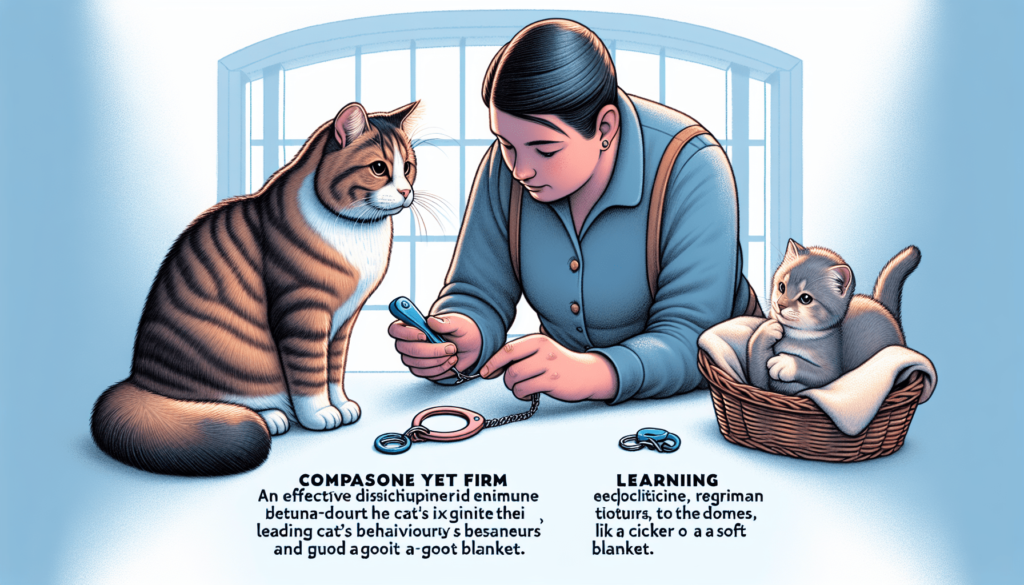So, you’ve recently brought a furry feline friend into your home, but you’re starting to realize that maintaining discipline with them is turning out to be quite the challenge. Fear not, for we are here to lend a helping hand! In this insightful article, we will explore effective strategies and techniques on how to discipline your cat without resorting to harsh punishments or causing stress. Embrace a harmonious coexistence with your four-legged companion as we delve into the fascinating world of feline discipline.
Understanding Cat Behavior
Cats are fascinating creatures with unique behaviors that can occasionally leave us puzzled. By understanding their behavior, we can create a harmonious environment for both cats and their human companions. Recognizing normal feline actions is the first step towards a better understanding. From a contented purr to a playful pounce, cats have a wide range of behaviors that are part of their natural instincts. Understanding these actions allows us to appreciate their needs and desires.
Differentiating between playful and harmful behaviors is essential for maintaining a safe and enjoyable environment. Playful behaviors, such as stalking and pouncing, are a natural part of a cat’s instinctive behavior. However, it is crucial to recognize when their play becomes aggressive or harmful. By observing their body language and reactions, you can differentiate between harmless play and behaviors that may harm themselves or others.
Identifying triggers and cues for bad behaviors is an important aspect of cat behavior understanding. Cats often exhibit certain behaviors as reactions to specific triggers or cues in their environment. It could be something as simple as the doorbell ringing or encountering a new person. By identifying these triggers, you can help minimize or eliminate the unwanted behaviors by addressing the root cause.
Establishing Communication
Cats are excellent communicators, but their methods may not always align with human communication styles. Understanding how cats use body language can greatly enhance our ability to interact with them effectively. Paying attention to their tail position, ear posture, and overall body stance can provide valuable insights into their emotional state and intentions.
Using specific voice tones or words is another way to communicate with cats. While they may not understand the words you say, they can pick up on the tone of your voice. A calm and soothing voice can convey a sense of safety and reassurance, while a stern tone can alert them to inappropriate behavior. Consistency in your tone will help cats associate certain behaviors with specific responses.
Understanding cat’s unique vocal signals is crucial for effective communication. Cats use a variety of vocalizations, ranging from soft meows to loud yowls, to express their needs and emotions. A purr often signifies contentment, while a hiss or growl indicates fear or aggression. By recognizing these vocal signals, you can respond accordingly and meet your cat’s needs or diffuse potential conflicts.

Implementing Immediate Consequences
Creating unpleasant but safe consequences for undesirable behaviors is an effective way to discourage cats from repeating them. For example, if your cat scratches the furniture, you can use a water spray bottle to lightly spray them. This serves as a deterrent without causing harm. Timely consequences are crucial, as cats need to associate the consequence with the behavior. Delayed consequences may confuse them and fail to make the connection.
It is important to avoid physical punishment when disciplining cats. Physical punishment not only damages the bond of trust between you and your cat but can also lead to fear or aggression. Instead, focus on implementing consequences that are safe, non-threatening, and easy for your cat to understand. By using positive reinforcement and immediate, non-violent consequences, you can guide your cat towards good behavior without causing harm.
Using Deterrents to Shape Behavior
Deterrents are a valuable tool for shaping a cat’s behavior and redirecting them away from unwanted actions. There are various types of deterrents that can be effective, including scents, textures, and sounds. Cats have a sensitive sense of smell, so using scents like citrus or lavender in areas you want to protect can deter them. Textures such as double-sided tape on furniture or aluminum foil on countertops can also discourage undesirable behaviors. Additionally, using sounds like a hissing noise from an automated device can startle cats and redirect their attention.
Placing deterrents effectively is essential for their success. Ensure they are strategically placed in areas where your cat tends to engage in undesired behaviors. Consistency is key, as cats need to associate the deterrent with the behavior they are trying to avoid. By using deterrence techniques, you can effectively communicate to your cat what is acceptable and what is not.

Redirecting Negative Behavior
Identifying substitute behaviors is an effective way to redirect your cat’s negative behavior towards more acceptable alternatives. For example, if your cat is scratching the furniture, provide them with a scratching post or a scratching pad nearby. Reward and praise your cat when they use the substitute behavior, reinforcing the positive action and deterring the negative behavior.
Positive reinforcement techniques play a vital role in redirecting negative behavior. When your cat exhibits the desired behavior, reward them with praise, petting, or treats. This positive reinforcement helps them understand which behaviors are desirable. By focusing on encouraging good behavior, you can help your cat develop positive habits and reduce instances of negative behavior.
Using toys and puzzles to distract and entertain your cat can be an effective way to redirect their attention away from undesirable activities. Provide toys that cater to their instincts, such as interactive toys that mimic hunting or toys that encourage mental stimulation. Regular playtime and engagement with your cat will not only redirect their energy but also strengthen the bond between you and your furry friend.
Training Cats Using Positive Reinforcement
Establishing a reward system is crucial when training cats. Positive reinforcement, such as treats, praises, or playtime, can motivate cats to repeat desired behaviors. By rewarding them immediately after they perform the behavior you want, you reinforce the association between the action and the reward, making it more likely for them to repeat the behavior in the future.
Choosing suitable rewards is important to ensure your cat is motivated. Different cats are motivated by different things, so look for rewards that your cat finds appealing. It could be high-quality treats, a favorite toy, or even interactive play. Experiment with various rewards to find what truly motivates your cat and tailor the rewards accordingly.
Timing the rewards correctly is essential in cat training. Rewards need to be given immediately after the desired behavior to reinforce the association. If you wait too long, your cat may not make the connection between their behavior and the reward. Consistency and prompt reward delivery will help your cat understand the desired behavior more effectively.
Avoiding Reinforcement of Negative Behaviors
Not relenting to your cat’s demands is vital in preventing the reinforcement of negative behaviors. Cats can be persistent, and giving in to their demands when they display undesirable behaviors only reinforces those behaviors. It is important to set and maintain boundaries to establish a well-behaved cat. Consistency is key, as your cat needs clear expectations to understand which behaviors are acceptable.
Resisting the urge to punish your cat is crucial for maintaining a healthy relationship. Punishment can lead to fear, stress, and anxiety, which can worsen the negative behaviors you’re trying to address. Instead, focus on positive reinforcement and redirection techniques to guide your cat towards desirable behaviors.
Not reinforcing negative behavior inadvertently is an important aspect of cat discipline. It’s important to be aware of unintentionally rewarding your cat when they display undesirable behaviors. For example, if your cat scratches the door and you let them in, they may interpret it as a reward for scratching. By avoiding inadvertent reinforcement, you can effectively shape your cat’s behavior in a positive direction.
Making Environmental Adjustments
Cat-proofing your house is crucial for creating a safe environment and preventing undesirable behaviors. Securely store hazardous substances, keep fragile objects out of reach, and provide appropriate climbing and scratching surfaces. By providing a cat-friendly environment, you can reduce the likelihood of destructive or harmful behaviors.
Providing interactive toys is essential for keeping your cat engaged and mentally stimulated. Cats need outlets for their natural instincts, such as hunting and playing. Choose toys that cater to these instincts, such as interactive puzzle toys or toys that mimic prey. Regularly rotating and introducing new toys can keep your cat entertained and prevent boredom-related behaviors.
Offering safe outdoor experiences, such as supervised play or enclosed outdoor spaces, can provide cats with an enriching environment. Many cats enjoy being outdoors and exploring their surroundings. By allowing them controlled access to the outdoors, you can satisfy their curiosity and prevent them from feeling confined. However, always ensure that outdoor environments are secure and free from potential dangers.
Addressing Aggression and Rough Play
Recognizing signs of aggression is crucial for addressing and managing aggressive behaviors in cats. Aggressive behaviors may include hissing, growling, biting, or scratching. These signs typically arise from fear, territorial disputes, or social dominance. By identifying these signs early on, you can intervene effectively and reduce the risk of escalation.
Intervention techniques play a crucial role in managing aggression and rough play. Redirect your cat’s attention to an appropriate toy or treat when you notice aggressive behavior or excessive rough play. This helps them associate positive experiences with appropriate outlets for their energy. Additionally, providing a safe space for your cat to retreat to when they feel threatened can help reduce aggression.
Seeking professional help is essential if you are unable to manage or resolve aggression and rough play behaviors on your own. A veterinarian or animal behaviorist can provide expert guidance and develop a customized plan to address your cat’s specific needs. They may recommend behavior modification techniques, medications, or additional resources to help you and your cat overcome these challenges.
Maintaining Consistent Training
Practicing patience and persistence is key to maintaining consistent training. Behavioral training takes time and effort, and it’s important to remember that cats have their own unique personalities and learning styles. Consistency in your approach and expectations will help your cat understand the desired behaviors more effectively.
The importance of routine cannot be understated in maintaining consistent training. Cats are creatures of habit and thrive on routine. Establish regular feeding times, play sessions, and training sessions to provide structure and predictability in your cat’s life. By incorporating training into their daily routine, you can reinforce desired behaviors and establish a well-behaved cat.
Dealing with setbacks in behavioral training is inevitable, but it’s important not to get discouraged. Cats may have off days or revert to old behaviors temporarily. Stay patient, consistent, and reinforce positive behavior through rewards and redirection. With time and perseverance, you can overcome setbacks and continue making progress in your cat’s behavioral training.
In conclusion, understanding cat behavior is crucial for creating a harmonious relationship with your feline friend. By recognizing normal feline actions, establishing effective communication, implementing immediate consequences, using deterrents, redirecting negative behavior, and maintaining positive reinforcement training, you can help shape your cat’s behavior in a positive direction. Remember to avoid punishment, make necessary environmental adjustments, address aggression and rough play, and maintain consistency in your training efforts. With patience and a friendly approach, you can create a happy and well-behaved cat.

